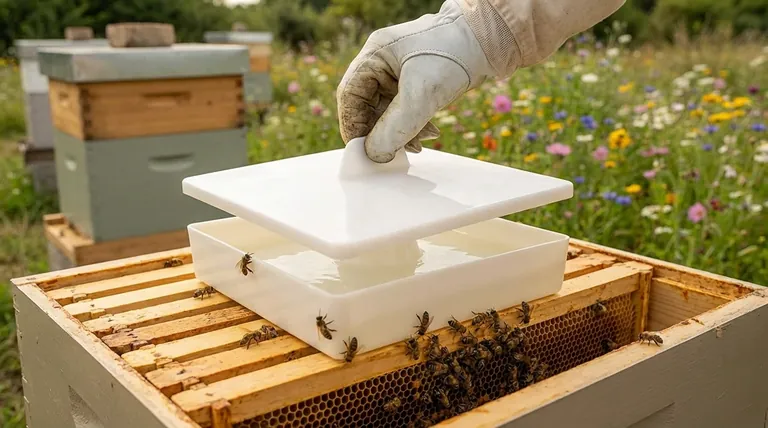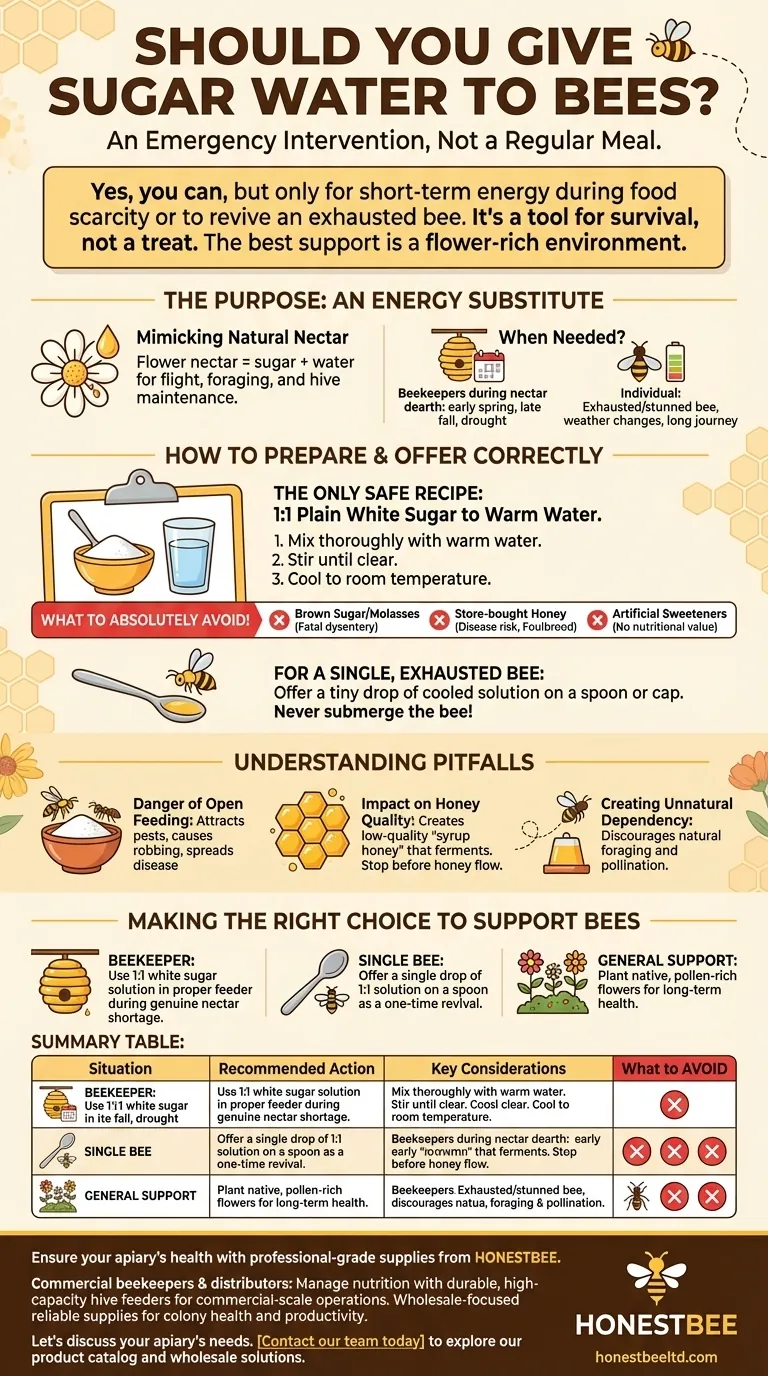Yes, you can give sugar water to bees, but it should be treated as an emergency intervention, not a regular meal. This solution is an effective short-term energy source for a honeybee colony during periods of low food availability or for reviving a single, exhausted bee. However, it is a substitute for their natural diet and should only be used in specific, necessary circumstances.
The most important takeaway is that sugar water is a tool for survival, not a treat. For beekeepers, it's a strategic resource to prevent starvation, while for the general public, it's a temporary first-aid measure for a struggling bee. The best long-term support for bees is always a flower-rich environment.

The Purpose of Sugar Water: An Energy Substitute
Mimicking Natural Nectar
Flower nectar, the primary food source for bees, is essentially a solution of sugar (carbohydrates) and water. It provides the immense energy bees need for flight, foraging, and maintaining the hive.
A simple sugar water solution acts as an effective artificial nectar. It delivers the necessary carbohydrates when natural sources are unavailable.
When Do Bees Need It?
For beekeepers, feeding is a management tool used during a nectar dearth. This occurs when few flowers are blooming, such as in early spring, late fall, or during a drought.
For an individual, you might encounter a single bee that appears exhausted or stunned, often due to weather changes or a long journey. A tiny amount of sugar water can provide the energy boost needed to return to its hive.
How to Prepare and Offer Sugar Water Correctly
The Only Safe Recipe
The standard, safe recipe is a 1:1 ratio of plain white sugar to warm water.
Use warm water (not boiling) to help the sugar dissolve completely. Stir until the solution is clear and let it cool to room temperature before offering it.
What to Absolutely Avoid
Never use brown sugar, molasses, or raw sugar. These contain solids that bees cannot digest and can cause dysentery, which is fatal.
Do not use honey, especially store-bought honey. It can carry spores of diseases like American Foulbrood that are devastating to bee colonies.
Artificial sweeteners have no nutritional value for bees and should never be used.
For a Single, Exhausted Bee
If you find a struggling bee, the goal is to offer a tiny amount of energy without risk.
Place a few drops of the cooled sugar water solution on a surface like a spoon or a bottle cap. Gently place the bee near the liquid, ensuring its wings and body do not get wet. Never submerge the bee, as it can easily drown.
Understanding the Pitfalls and When to Avoid Feeding
The Danger of Open Feeding
Never leave a large, open container of sugar water outside. This practice, known as open feeding, creates significant problems.
It can attract pests like wasps and ants, incite "robbing" (where bees from stronger hives attack weaker ones to steal resources), and facilitate the rapid spread of diseases between colonies.
Impact on Honey Quality
Beekeepers must stop feeding sugar water well before they intend to harvest honey.
If bees collect and store sugar water in the honeycomb, it creates a low-quality, uncapped "syrup honey" that is not true honey and will ferment. Bees naturally prefer real nectar and will ignore feeders when flowers are blooming.
Creating Unnatural Dependency
Routinely providing sugar water when natural sources are plentiful can discourage bees from their essential job of foraging and pollination. It interferes with their natural behavior and the ecosystem they support.
Making the Right Choice to Support Bees
Your approach should depend on your goal and your role in the bees' environment.
- If you are a beekeeper: Use a 1:1 white sugar solution in a proper hive feeder only when your colony faces a genuine nectar shortage.
- If you find a single, struggling bee: Offer a single drop of 1:1 sugar water on a spoon as a one-time revival measure.
- If your primary goal is to help all bees: The most impactful action is to plant a variety of native, pollen-rich flowers that bloom throughout the seasons.
Ultimately, the best support you can provide is a healthy, natural environment where bees can thrive on their own.
Summary Table:
| Situation | Recommended Action | Key Considerations |
|---|---|---|
| Exhausted Single Bee | Offer a tiny drop of 1:1 sugar water on a spoon. | A one-time revival measure. Ensure the bee doesn't get wet. |
| Beekeeper: Nectar Dearth | Use a proper hive feeder with 1:1 white sugar solution. | A strategic intervention to prevent starvation. Stop before honey flow. |
| General Bee Support | Plant a variety of native, pollen-rich flowers. | The best long-term solution for bee health and pollination. |
| What to AVOID | Never use honey, brown sugar, or leave open feeders. | Prevents disease spread, dysentery, and robbing behavior. |
Ensure your apiary's health with professional-grade supplies from HONESTBEE.
As a commercial beekeeper or distributor, managing colony nutrition is critical to your operation's success. While sugar water is a vital emergency tool, having the right equipment is essential for effective and safe feeding practices.
HONESTBEE supplies durable, high-capacity hive feeders and other essential beekeeping equipment designed for the demands of commercial-scale operations. Our wholesale-focused model ensures you get the reliable supplies you need to support your colonies' health and productivity efficiently.
Let's discuss your apiary's needs. Contact our team today to explore our product catalog and wholesale solutions tailored for commercial beekeepers and distributors.
Visual Guide

Related Products
- HONESTBEE Professional Hive Top Bee Feeder Feeding Solution
- HONESTBEE Entrance Bee Feeder Professional Hive Nutrition Solution for Beekeeping
- HONESTBEE Round Hive Top Bee Feeder for Syrup
- HONESTBEE Professional Long Handled Hive Tool with Precision Cutting Blade
- Rapid Bee Feeder White Plastic 2L Round Top Feeder for 8 or 10-Frame Bee Hives
People Also Ask
- What is the best way to top feed bees? A Safe, High-Volume Feeding Solution for Your Apiary
- What is a top feeder for bees? Maximize Colony Health with Efficient Feeding
- What features make top feeders a reliable choice for beekeepers? A Guide to Safe, Efficient Hive Nutrition
- What safety features are included in top feeders? A Guide to Drowning Prevention and Hive Safety
- How do I keep bees from drowning in my top feeder? Ensure Safe Feeding for Your Hive



















